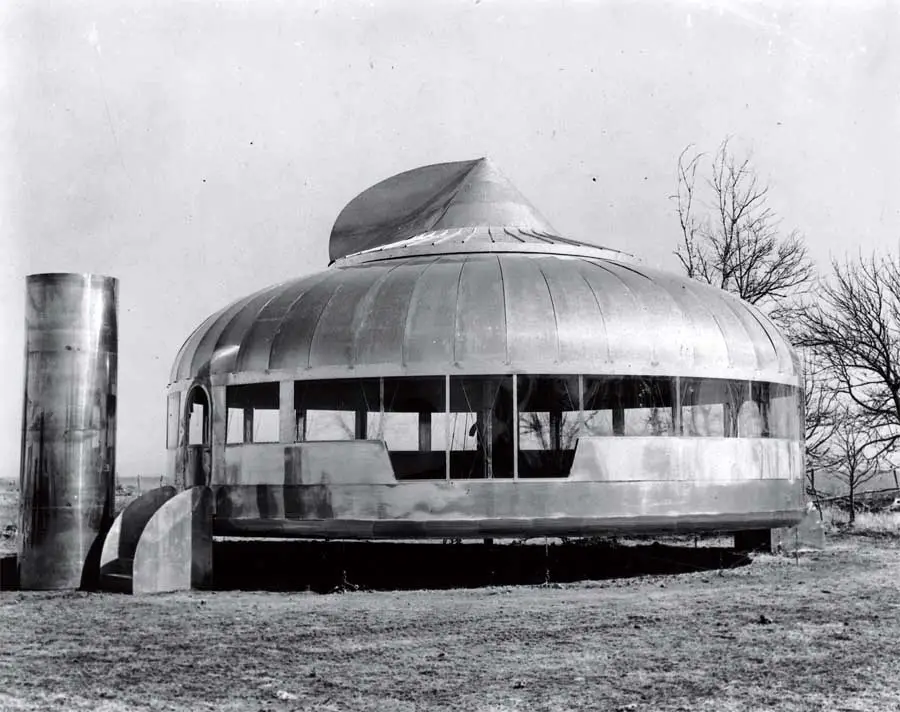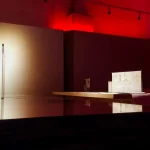Bucky Fuller & Spaceship Earth Madrid design, Spanish architecture exhibition news
Bucky Fuller & Spaceship Earth Exhibition, Spain
Bucky Fuller Architecture Exhibition, Madrid
Aug 17, 2010
Curators: Norman Foster and Luis Fernández-Galiano
Dates: 1 Sep – 30 Oct 2010
Mon-Fri 10:00-14:00 / 16:30-19:00. Sat: 11:00-14:00
Venue: Ivorypress Art + Books
C/ Comandante Zorita 48, 28020 Madrid, Spain
Contact: T +34 91 449 09 61
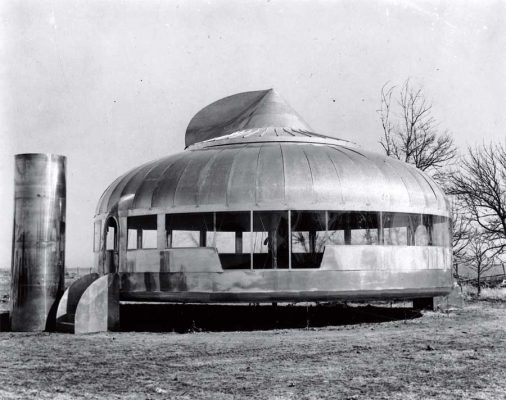
Dymaxion house photo © The State of R. Buckminster Fuller
Bucky Fuller & Spaceship Earth exhibition
Ivorypress Art + Books presents
BUCKY FULLER & SPACESHIP EARTH
The first exhibition in Spain on BUCKMINSTER FULLER: visionary, architect, philosopher, mathematician and cartographer.
Inauguration 9 Sep 2010 19:30
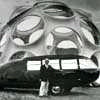
Buckminster Fuller picture from Ivory Press
Debates
• Bucky Fuller: Setting the Stage: 9 September at 12:30 pm. Participants will include
Allegra Fuller, daughter of Buckminster Fuller; Thomas Zung, architect and partner of Fuller; and Norman Foster and Luis Fernández-Galiano, the exhibition curators.
• Bucky Fuller Today: His Influence on Architecture, Contemporary Art and Science: 11
September at 9:00 pm. Participants will include Benedetta Tagliabue, Juan Herreros, and Alejandro Zaera Polo; Luis Fernández-Galiano will act as moderator.
As part of the architecture series that Ivorypress Art + Books holds every September and October, the company, in collaboration with Foster + Partners, is organising the Bucky Fuller & Spaceship Earth exhibition, the first of its kind in Spain on the American visionary, architect, designer, philosopher, mathematician and cartographer.
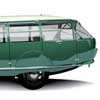
Dymaxion car photo © The State of R. Buckminster Fuller
The exhibition, curated by the architect Norman Foster, with whom Fuller collaborated and had a close relationship during the last twelve years of his life, and Luis Fernández-Galiano, architect and professor of architectural projects at Universidad Politécnica de Madrid, reviews Fuller’s work with a full biographical account, from the pioneering Dymaxion House to his famous geodesic domes.
The exhibition, on display at Ivorypress Art + Books from 1 September to 30 October 2010, has been made possible thanks to the Estate of Buckminster Fuller and public institutions including Stanford University, Southern Illinois University, the Art Institute of Chicago, as well as private collections.
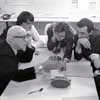
Bucky in action photo © Tim Street Porter
The early career of “Bucky” coincided with the age of aerodynamics, a field that ranged from airship and aeroplane design to cars, trains and even house building. Now, for the first time in Spain, Fuller’s designs are available to the public, designs that paved the way for some of the most avant-garde ideas of the last century.
The selected works reflect the key chapters in Buckminster Fuller’s career, with originals—photos, drawings, projects, models and structures—as well as a replica of his futuristic Dymaxion Car #4. Along with the pieces and projects that comprise the exhibition, Ivorypress will present two documentaries specifically produced for the exhibition.
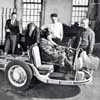
Dymaxion car photo © The State of R. Buckminster Fuller
Spaceship Earth
A precursor to current environmentalism, Buckminster Fuller addressed issues that are vital for our society today. His projects reflected a deep concern about the fragility of our planet which, from 1951 onwards, he referred to as Spaceship Earth.
Fuller argued that the Earth should be understood as a vehicle that transports us through space. He explained that the ship’s resources were limited and, therefore, it was fundamental to rationalise their consumption and search for sustainable transport and structures. “His work, along with his observations, are actually more important now than they were during his lifetime”, explained Norman Foster. He dedicated his work to making our planet more manageable, directing it in a sustainable way, taking on a leadership role in defence of the environment and concern for a democratic architecture within everyone’s reach. The bulk of these ideas, didactically spread, were developed in the 1920s and gradually disseminated through society. Today they are fully valid.
Many years before the first ecologist organisations were founded or the word “sustainability” was coined, ‘Bucky’ Fuller designed the first self-sufficient buildings and invented low-fuel consumption aerodynamic cars which resembled a drop of water, capable of carrying up to twelve people.
In this way, states Luis Fernández-Galiano, “in the last stage of Fuller’s life, his work and his persona became a legend for the alternative movement, adopting his geodesic domes as a way to inhabit the planet, economising on resources and empathising with nature”. Over time, Fuller “became an authentic guru for countercultural groups and ecologists, who flocked to his conferences”.
The Dymaxion Project
The exhibition produced by Ivorypress Art + Books presents an overview of the extensive work of Buckminster Fuller, framed in the context of his time. Part of the exhibits fall into the Dymaxion concept, a term devised by the public relations department of the Marshall Field’s department stores in Chicago, where Fuller displayed one of his first houses in 1929 (the Dymaxion House). The neologism combines three words that appeared frequently in Fuller’s explanations: dynamics, maximum, and tension. The architect was passionate about the term, and he would use it to describe a collection of Dymaxion projects inspired by the maxim “more for less”.
The history of the Dymaxion Car, one of his most renowned works and the forerunner of low-consumption aerodynamic vehicles, is included in the book published especially for this Ivorypress exhibition, Dymaxion Car Buckminster Fuller. This display features the latest reconstruction of the Dymaxion Car #4 undertaken by Norman Foster especially for this event as a tribute to Fuller, who was his mentor and friend. “My starting point when deciding to create the Dymaxion Car # 4 was a mixture of curiosity and a desire to pay tribute to Bucky, a way to express my gratitude for his wisdom and for his valuable way of understanding things that have helped shape my own life”.
The documentaries produced by Ivorypress on Buckminster Fuller contextualise the work of the architect with his era and collects testimonies from the period, highlighting the advanced nature of his ideas at that time.
The venue will host different Dymaxion developments, such as the Dymaxion Deployment Unit (DDU), an emergency shelter, “designed in 1941 and inspired by the metallic agricultural silos that had proliferated since the New Deal agricultural policy, to which Fuller added portholes and a ventilation system at the top of the conical roof”, explains Fernández-Galiano. Tens of thousands of them were built, primarily used by the US army.
The exhibition will also include a sample of his work as a cartographer. His studies on the geodesic sphere and the geodesic meshes created a new projection system for the world map, called the Dymaxion Map. In addition, various projects on geodesic domes will be exhibited, the domes being “the most fertile of Fuller’s inventions, the one that best gathers together his overall thinking with his constructive intelligence and the one which most indelibly we associate with his persona and his legacy”, according to Fernández-Galiano, co-curator of the exhibition.
Some utopian proposals became reality, for example, the US pavilion at the Montreal Universal Exhibition in 1967. The spherical construction, undertaken with his young collaborator Shoji Sadao, captured the world’s attention and awarded Fuller popular consecration, resulting in a proliferation of geodesic domes.
Bucky Fuller & Spaceship Earth will constitute a tour of his prophetic and visionary work which, in the words of Fernández-Galiano, “contributed to the global flourishing of environmental awareness and the dissemination of technical and scientific knowledge as a key tool for safeguarding and using our fragile blue planet”.
Debates Series
As part of exhibition, Bucky Fuller & Spaceship Earth, a series of debates will be held to reflect on the life and work of the architect and designer, Richard Buckminster Fuller.
• Bucky Fuller: Setting the Stage
The first debate will take place on 9 September at 12:30 pm. Participants will include Allegra Fuller, daughter of Buckminster Fuller; Thomas Zung, architect and partner of Fuller; and Norman Foster and Luis Fernández-Galiano, the exhibition curators.
• Bucky Fuller Today: His influence on Architecture, Contemporary Art and Science
The second debate will be held on 11 September at 9:00 pm, coinciding with Madrid’s Noche en Blanco (a Europe-wide cultural event), and will focus on the influence of Fuller’s ideas on the new generation of architects. Participants will include Benedetta Tagliabue, Juan Herreros, and Alejandro Zaera Polo; Luis Fernández-Galiano will serve as moderator.
BUCKY FULLER & SPACESHIP EARTH
Richard Buckminster ‘Bucky’ Fuller (1895-1983) was an American genius who defied categorisation. He could be described variously as a green environmentalist, a prophetic visionary, a poet, architect, mathematician, map-maker and teacher, although he is most popularly known for his geodesic domes.
I was privileged to collaborate with Bucky for the last 12 years of his life and this had a profound influence on my own work and thinking. Inevitably, I also gained an insight into his philosophy and achievements. With Luis Fernández-Galiano, my co-curator for this exhibition, we have tried to show Bucky and the broad range of his work in the context of his time.
Bucky’s early career coincided with the streamline age which touched everything from the design of Zeppelins and aircraft to cars and trains and even houses. We reveal how these designs set the scene for some of his most radical proposals in the late 1920s and ‘30s. The exhibition charts the key chapters of Bucky’s long career using photographs, original drawings, models and structures together with the recently completed recreation of his futuristic Dymaxion Car, which is shown here for the first time.
In 1951 Fuller drew attention to the ecological issues of today when he referred to ‘spaceship earth’ and the fragility of the planet, as such his work and observations are even more important now than they were in his lifetime.
Norman Foster
This exhibition has been produced in collaboration with Foster + Partners
Ivorypress Art + Books
C/ Comandante Zorita 48
28020 Madrid Spain
Foster + Partners – images / information on key buildings
Location: 28020 Madrid, Spain
Madrid Architecture
Madrid Architecture Designs – chronological list
Madrid Architecture – Selection
Foster + Partners
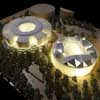
image : Foster + Partners
City of Justice Madrid
, Avenida de América
various interiors by famous architects
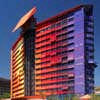
image from Hotel Puerta America website
Hotel Puerta America
High Council – Chambers of Commerce
Rafael de La-Hoz Arquitectos

photograph : Miguel de Guzmán
Chambers of Commerce Madrid
Memorial, Atocha Station Building
FAM Arquitectura y Urbanismo

picture from the architect
Madrid memorial
Design: Foreign Office Architects
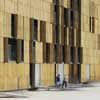
photograph © Sérgio Padura
Carabanchel Housing
Fundación Canal Exhibition Madrid
Zaha Hadid Exhibitions Designs
Comments / photos for the Bucky Fuller & Spaceship Earth Architecture Exhibition page welcome

